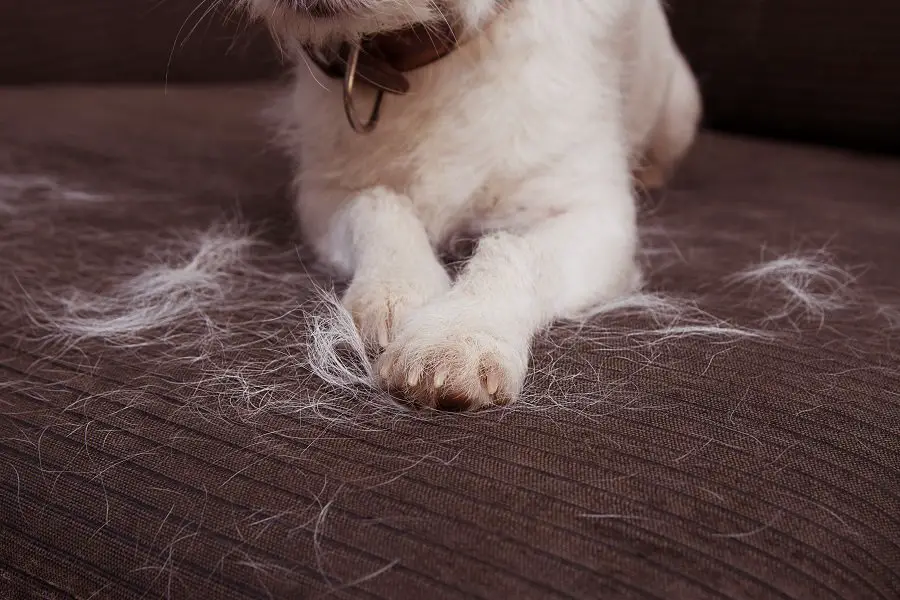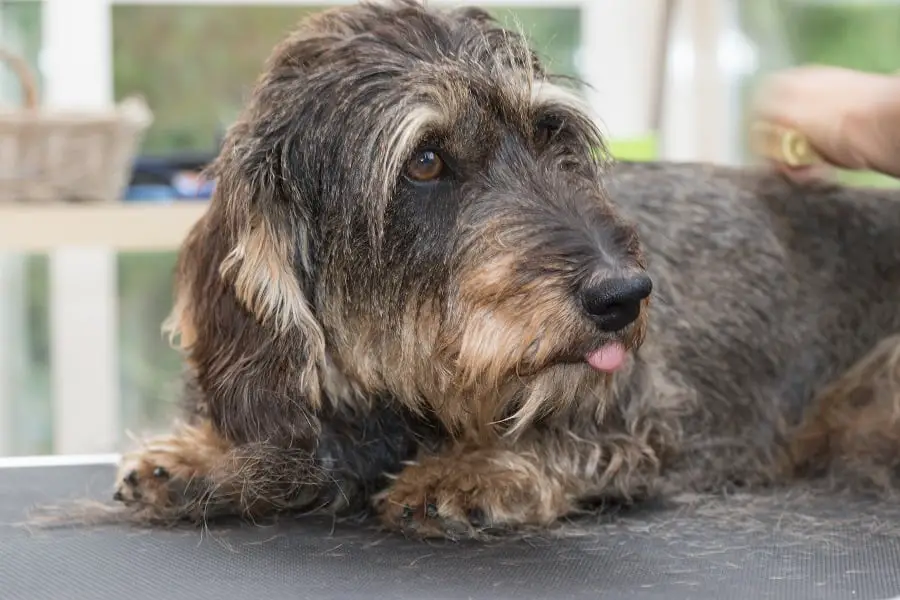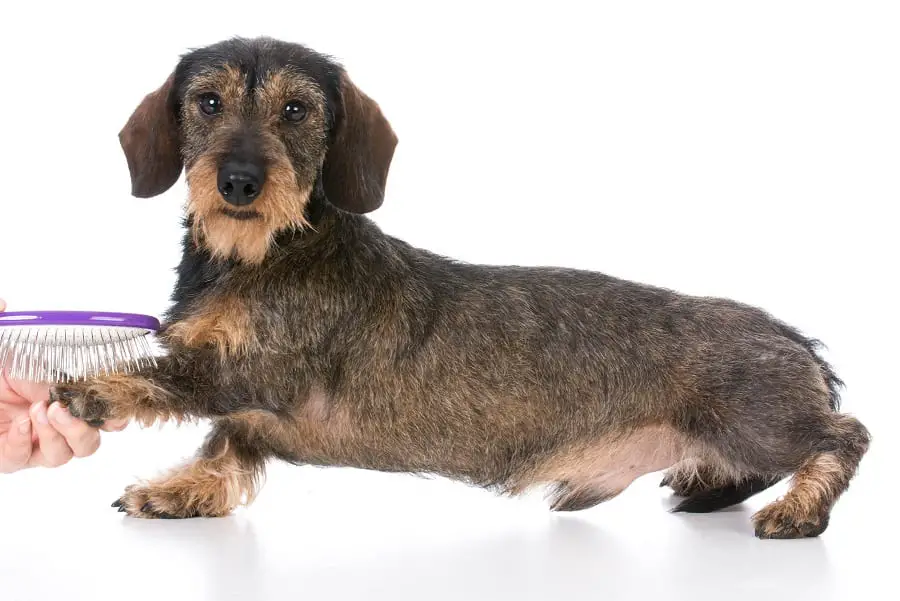The wily and loveable Dachshund breed comes in two sizes, several beautiful colours, and three distinctive coats, which are Smooth (the most common in North America), Longhaired and Wirehaired (least common in North America–found primarily in Germany).
In this article, the main focus is the intelligent Wirehaired Dachshund. The breed’s origins are estimated to be in the 16th century.
They are considered to be the ‘grandfather’ of all dachshunds and were used to hunt wild boar, foxes and badgers.

Doxies are amazing pets, but one of the messier aspects of being a dog owner is shedding. Hairs on couches, on upholstery and on the carpet. The list goes on! Yikes!
We’re going to explore if you’ll need to purchase a new vacuum when you bring your new Wirehaired Dachshund home or if regular grooming maintenance will help ease your shedding anxiety.
A Bit of Background…
The Wirehaired Dachshund is not as common as its Smooth and Longhaired cousins here in North America; they are much more commonplace in Germany.
Your Wirehaired friend will have a wiry, rough overcoat and a soft undercoat. They also boast bushy eyebrows, a beard and even fur on their ears. That’s a lot of hair.
They were bred this way to help them endure harsh weather conditions whilst hunting elusive prey. It is theorized that the Wirehaired coat tends to make the personality of this little dog a bit more mischievous, intelligent and energetic than the other coat types.
Of course, this is a generalization and proper training and positive reinforcement is very important.
So, Do They Shed?
In a word? Yes! All Dachshunds shed at least a little bit. Indeed, there is no breed of dog with fur that doesn’t shed.

Dachshund shedding habits vary from coat to coat. Longhaired and Wirehaired doxies do shed more predominantly during the Spring and Fall season changes.
The key here is that Wirehaired doxies have a very distinct and unique double coat. Both undercoat and overcoat tend to be on the shorter side.
Due to this structure, you may not notice much shedding as the dead hairs often don’t fall out as much as they embed into the wiry, rough overcoat and soft undercoat.
With that in mind, you may notice Longhaired doxies shedding more as their hair is dense, long, smooth and therefore more noticeable.
It is thought that the Wirehaired bristly overcoat doesn’t shed, but the undercoat absolutely does. This is why grooming is so important for the Wirehaired doxie.
Read on, and you’ll find some techniques to make life easier for your furry friend, and for yourself.
Okay, So How Often Do They Shed?
Shedding dead hair for most healthy dogs takes place year round.
However, the most prominent shedding occurs in the Spring and in the Fall for Wirehairs due to their double coat structure.
The seasonal process of shedding is known as ‘molting’ or ‘blowing the coat’. They shed their thicker undercoats in the Spring for a lighter outfit.
When it cools again, they shed their lighter undercoat and grow a warmer, thicker undercoat. You wouldn’t need to wear a parka in July, would you?
How Much Shedding Can I Expect?
Wirehaired doxies and Dachshunds in general are considered moderate to low shedders. Generally though, Wirehaired doxies appear to shed the least out of the three.
Even though they do have the double coat, they and their Smooth Dachshund cousins have relatively short, small hair.
While it is a fact that Wirehaired doxies do have short hair and are moderate shedders, bear in mind that they still need to be regularly brushed and groomed. Be wary of becoming complacent if you don’t see any hairs on your couch.
This does not mean that they do not shed. If you haven’t brushed in a few days, it’s more than likely that the dead hair has embedded in your Wirehair’s under and overcoats.
Health Considerations:
Shedding can also occur outside of the expected ‘nature of things’.
Stress, skin conditions and a poor diet can contribute to excessive shedding. It’s important to feed your Wirehair a balanced diet of nutritious dog food. This ensures that your doxie gets all necessary vitamins and minerals.

Excessive shedding can be difficult and anxiety inducing to deal with, especially if you find yourself vacuuming more than any other chore you do.
There are ways to manage problematic shedding. Ensure proper grooming and bathing is incorporated in your routine. Be sure to consider any other factors that could contribute to abnormal shedding; age, hydration levels, hormonal changes, and medication can be culprits as well.
Contact a trusted veterinarian for advice and they may be able to recommend specific shampoos and treatments. Regularly check for fleas or ticks and be sure to follow guidelines for any medications prescribed to your Wirehaired.
If the excessive shedding is not too serious, there are some home remedies to consider before pulling out the big veterinarian guns. Omega-3 fatty acids have been known to be excellent for a dog’s overall health.
The benefits include soothing skin irritations, joint pain, overshedding issues and heart health to name a few. Fish oil and olive oil are effective and easy to find sources of Omega-3’s and can be easily incorporated into your Wirehaired doxie’s daily routine.
As stated, hydration levels can be a contributing factor. Consider incorporating more wet dog food into your doxie’s diet, it can have up to 75% moisture levels while dry food has up to 10%.
Small amounts of molasses has also been seen to be helpful in reducing shedding and is full of antioxidants and minerals.
Grooming Techniques:
The importance of regularly grooming your Wirehair doxie cannot be overstated. As we’ve covered, a good portion of shed hair embeds itself in the soft undercoat and rough overcoat.
As such, daily grooming is required to remove the dead hair. Avoiding difficult matting and to keep your Wirehair looking and feeling their best is a must. Regular brushing also helps to distribute the skin’s natural oils throughout, which helps the coat shine and keeps the skin healthy.
Bathing is of course another necessary component of grooming, but typically is done once every 2-3 months, so as not to strip these natural oils from the skin. In the summer, you might consider bathing your Wirehair a bit more frequently, especially if you are quite active with them.

As for hardware, a wire bristle brush and an undercoat rake brush are the most effective tools to get rid of loose and dead hair.
Use with caution and make sure to try and incorporate this into your routine at least four times weekly, with daily being preferred.
A technique known as “stripping” should be used once or twice a year, especially if your Wirehair is involved in Kennel shows. This involves plucking (by hand or by using a special comb) the hair and fur from the root to allow a new, fresh coat to grow in.
This also helps maintain the wiry texture of the top coat and helps in reducing shedding. You might consider using a groomer for this technique, or have one show you how to do it as this takes a great deal of skill and patience.
A less favored alternative is simply ‘clipping’ the top wire coat and trimming semi regularly thereafter. Either way, the length of the top coat should be from a ½ to ¾ of an inch.
Facial grooming including trimming the eyebrows and beard should be looked after as well. Typically this is recommended to be done through a groomer.
This controlled, frequent grooming approach reduces the overall typical shedding on couches or beds. This proves to be very helpful for those with allergies.
Of course, it is not the actual fur that triggers an allergic reaction but primarily the dander attached to the fur.
One thing to remember is that these doxies are unfortunately not hypoallergenic, but with proper daily grooming, you can reduce the amount of hair and allergens left around your house and reduce any symptoms that you or a family member may experience.
Bear in mind that grooming an obstinate Wirehaired doxie is no walk in the park; your Wirehair will likely behave dramatically and try to wriggle free.
Starting from a young age is important. Be sure to include positive reinforcement with dog treats and kind words to encourage your Wirehair to cooperate (and because they’re so darn cute).
Remember that you must be consistent and persistent in your routine or they’ll know that they can get away employing a bad attitude to get out of ‘spa day’.
To Summarize:
If you’re looking for a playful, amusing and fiesty addition to your family but have shedding concerns due to allergies or overall cleanliness, then I highly recommend the Wirehaired Dachshund. Simply put–they DO shed, but very minimally.
Their Longhaired cousins are thought to be the biggest shedding culprits. As long as proper care is taken with grooming and bathing their unique double coats, you should not experience much shedding on your furniture.
